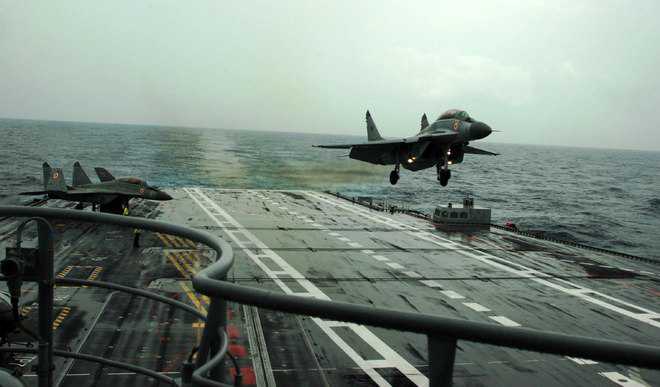The Indian Navy’s Poseidon 8I anti-submarine warfare aircraft have been deployed in eastern Ladakh to carry out surveillance along the Line of Actual Control (LAC) and some of its MiG-29K jets are likely to be stationed in key IAF bases in the northern sector amid the border row with China, sources said on Tuesday.
The sources said the military brass is considering deploying Indian Navy’s MiG-29K fighter jets in a couple of air bases in the northern sector as part of efforts to bring in tri-services synergy in dealing with national security challenges.
The maritime fighter jets will complement the Indian Air Force’s (IAF) efforts to significantly boost deep strikes and air dominance capabilities, they said
At present, the Navy has a fleet of around 40 MiG-29K jets and at least 18 of them are deployed on board the country’s aircraft carrier INS Vikramaditya.
The IAF has already positioned almost all its frontline fighter jets like Sukhoi 30 MKI, Jaguar and Mirage 2000 aircraft in the key frontier air bases in eastern Ladakh and elsewhere along the LAC, a move that came against the backdrop of the border row with China. Diplomatic and military talks between China and India are continuing for complete disengagement of troops from a number of friction points in eastern Ladakh.
The IAF has been carrying out night time combat air patrols over the eastern Ladakh region in the last few weeks as part of its preparedness to deal with any eventualities in the mountainous region.
By the second half of August, the IAF is planning to deploy five Rafale fighter jets in the Ladakh sector which are expected to significantly enhance its combat capabilities. India is scheduled to receive the first batch of five Rafale jets on July 27.
As part of its high-level of alertness, the IAF has also deployed Apache attack choppers as well as Chinook heavy-lift helicopters to transport troops to various forward locations in eastern Ladakh.
The sources said Poseidon 8I aircraft of the Navy has been deployed for monitoring the movement of Chinese troops in eastern Ladakh. The long-range anti-submarine and reconnaissance aircraft was deployed in Doklam along the Sikkim border too during the 73-day standoff between Indian and Chinese troops in 2017.
The P-8Is were also deployed to keep an eye on movement of Pakistani troops after the Pulwama terror attack last year.
In the midst of the border row with China, the Indian Navy on Monday and Tuesday carried out a military drill with a US Navy carrier strike group led by nuclear-powered aircraft carrier USS Nimitz off the coast of Andaman and Nicobar Islands.
Four frontline warships of the Indian Navy participated in the “PASSEX” exercise when the US carrier strike group was transiting through the Indian Ocean Region (IOR) on its way from the South China Sea, officials said.
The USS Nimitz is the world’s largest warship and the exercise between the two navies assumed significance as it took place in the midst of China’s renewed military assertiveness in eastern Ladakh as well as in South China Sea.
The US Navy carrier strike Group comprises USS Nimitz, Ticonderoga-class guided missile cruiser USS Princeton and Arleigh Burke-class guided missile destroyers USS Sterett and USS Ralph Johnson, the officials said.
India carried out similar exercises with the Japanese navy last month.
The Indian Navy has increased its surveillance missions and strengthened operational deployment in the IOR in the wake of the bitter border standoff with China in eastern Ladakh.
The Indian Navy is also ramping up its operational cooperation with various friendly naval forces like the US Navy and Japan Maritime Self Defense Force in view of the fast evolving regional security landscape, the officials said.
Navies from the US, India, Australia, Japan and France have been deepening their mutual cooperation in the IOR in view of China’s growing attempt to expand military influence in the resource rich region.
Following escalation in tension between India and China in eastern Ladakh, the government put all the three forces on high alert. The Indian Navy was asked to raise its alert-level in the IOR where Chinese Navy has been making regular forays.

